by: Debrah Wright
As Waco prepares for its municipal elections, attention turns to the candidates and the diverse issues they aim to tackle. The mayoral race, in particular, has garnered interest, with candidates offering varied approaches to address the city’s challenges and opportunities.
**Mark Your Calendars: Election Details**
The general election for the City of Waco Mayor and Council Members for Districts I and III is scheduled for Saturday, May 4, 2024. Early voting will be open from April 22 through April 30, 2024, providing flexibility for residents to participate. Following the election, those elected will be sworn in at a Special Meeting on May 14, 2024, at 6 p.m.
**Accessible Voting Locations and Times:**
McLennan County has designated multiple early voting sites, including the Records Building, community centers, and libraries, ensuring accessibility for all residents. The early voting schedule offers extended hours, accommodating diverse schedules and commitments. Below are the early voting locations and times:
– McLennan County Records Building: 214 N 4th Street, Suite 300
– Robinson Community Center: 106 W. Lyndale Avenue
– Waco Multi-Purpose Community Center: 1020 Elm Avenue
– West Waco Library: 5301 Bosque Blvd
– Hewitt City Hall: 200 Patriot Court
Early voting times are as follows:
– Monday, April 22 to Friday, April 26: 8 a.m. to 5 p.m. each day
– Saturday, April 27: 7 a.m. to 7 p.m.
– Sunday, April 28: 1 to 6 p.m.
– Monday, April 29 to Tuesday, April 30: 7 a.m. to 7 p.m. each day
The mayoral race features three candidates:
Three candidates are vying to become the next mayor of Waco, to be decided in May. Jim Holmes, the District 5 council member and mayor pro tem; Aubrey Robertson, an attorney and former Democratic candidate for McLennan County district attorney; and Eric Brown, a pastor and activist, have each filed for the seat. The winner of the May 4 election will succeed Dillon Meek.
**Jim Holmes:** Jim Holmes has served on the Waco City Council since 2016. With 35 years of financial management experience, including roles as COO/EVP of FirstCity Financial Corp & SVP of FNB of Central Texas, he brings a wealth of expertise. Currently, he serves as President of HOTCOG, Chairman of Waco MPO, & Board Director for Waco Sports Commission & Cameron Park Zoo. Jim is a graduate of Creighton University and attended Baylor School of Law. Bringing a background in public service, Holmes emphasizes infrastructure investment and economic development as key priorities for Waco’s future. (https://www.jimholmeswaco.org/)
**Aubrey Robertson:** Aubrey Robertson is an attorney with a background in Political Science and Slavic and Eastern European Studies. Transitioning from aspiring to draft constitutions for former Soviet countries to focusing on the criminal justice system, he gained experience in mock trials and criminal law clinics. Aubrey’s extensive experience includes pro bono work, internships, and roles as both a prosecutor and defense attorney. Currently serving as the District Court Felony Chief at the Law Offices of Vic Feazell, P.C., he prioritizes keeping clients informed and confident throughout legal proceedings. With a focus on economic revitalization and community empowerment, Robertson aims to foster small business growth and expand access to affordable housing, known for his stance on Public safety. (https://www.aubreyforda.com/)
**Eric Brown:** Eric Brown brings a dedication to public service and community advocacy. With a background in business administration, he focuses on economic development, education, affordable housing, public safety, environmental sustainability, and social equity. Eric aims to create a brighter future for all residents through innovative solutions and active listening to community voices. Advocating for grassroots initiatives and sustainable development, Brown prioritizes environmental stewardship, social equity, and inclusive governance. (https://www.ericforwaco.com/)
In addition to the mayoral race, other important contests include:
– Waco Independent School District Board of Trustees At-Large, Place 6: Keith Guillory and Lauren Caldwell offer their visions for the future of education in Waco.
– McLennan Central Appraisal District Board Member, Place 2: David R. Schleicher and Perry Felton vie for this position, focusing on fair property assessments.
– McLennan Central Appraisal District Board Member, Place 3: William “Bill” W. Vernon, Jr., Linda Hatchel, and Dennis DeGraff compete for this seat, each with their own ideas for effective property valuation practices.
**Get Involved: Exercise Your Right to Vote**
As the election approaches, it’s crucial for Waco residents to educate themselves on the candidates and their platforms. Whether casting their ballots during early voting or on Election Day, every vote counts in shaping the future of the city. For more information on voting locations and ballots, residents can visit mclennan.gov/elections and make their voices heard in this pivotal election.

(City council, school board, planning commission, county commissioners – these groups and several others represent us. They do the day to day work of running our community. It is our responsibility to keep informed about their work so that we can help them represent us effectively. “Civic Insights” by Jeffrey Vitarius is a regular feature of Act Locally Waco. Its purpose is to help us understand decisions that shape our community so that we can participate effectively as informed, engaged residents of Waco. – ALW)

By Jeffrey Vitarius
We hope you all had a safe and enjoyable Thanksgiving and thought it might be good to start back up with a topic we find particularly interesting, bus rapid transit (BRT).
Next Thursday (December 10th, 2020) at 6:00 pm Waco Transit, the Waco Metropolitan Planning Organization (MPO), and AECOM Technical Services are hosting a virtual meeting to gather public input on station locations and designs for the BRT project. AECOM also recently provided updates to the City Council and MPO on the progress of the project. Let’s take a look at why this project is being considered and what stage of the process we are in now.
Way back in 2013-4, the City of Waco commissioned an Economic Development Strategic Plan from the W.E. Upjohn Institute for Employment Research. The study is generally called the Upjohn Report. Unlike a standard economic development strategy that focuses purely on the “general economic performance of the area,” the City “called for a plan to also reduce poverty, increase labor force participation, and increase area income.” That is, rather than focus on economic growth in and of itself, the plan also focused on how that growth might be made equitable for the people of Waco. This focus on equitable development rather than just any development remains an important goal of the City.
In the process of drafting their report, the Upjohn team interviewed ninety individuals, asking them (in part) about what challenges they see to finding and retaining employment. The result, “transportation was overwhelmingly cited as the most prominent barrier to finding and keeping a job.” In 2018, about 8% of Wacoans got to work by a means other than a car. At that time approximately 29% of Wacoan households had no car or 1 car. The average household size in Waco is about 2.5 people meaning that having one car could mean a household is still reliant on a non-car means of getting to work.
Although walking or cycling remain valuable commuting options for folks (your author does so whenever he can), needing to rely on your feet or your bike makes you vulnerable to long distances and poor weather (especially August heat). Given these challenges, it is critical for those in Waco who do not have ready access to a car that public transit gets people where they need to go reliably and as swiftly as possible.
The current Waco transit system is configured as a “spoke and hub.” In this design bus routes extend out from the City core to residential neighborhoods, job centers, and service locations before returning Downtown. The routes out and back are the “spokes” with the Downtown Transit Center as the “hub.” The transit map below shows how the various routes converge at the transit center downtown before spanning out across the city.
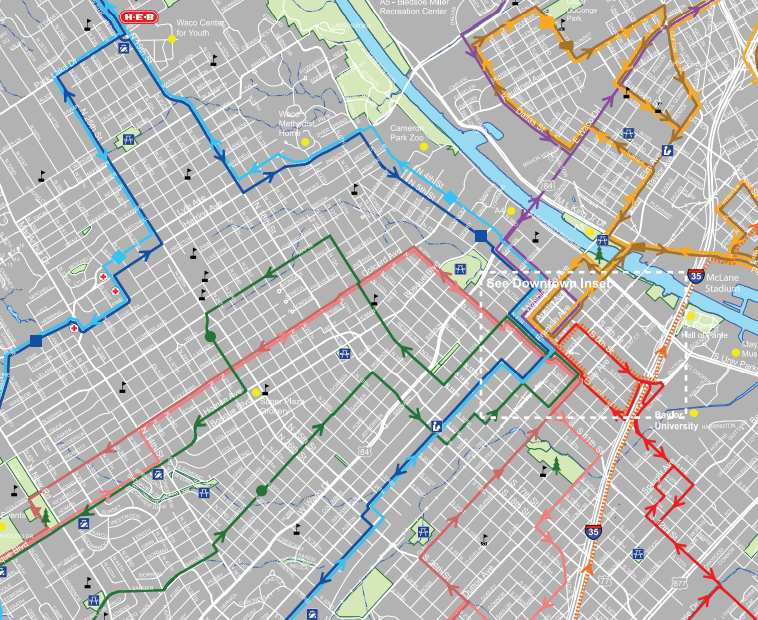
(Map 1)
This configuration has its challenges. The spoke and hub setup means that to get from one side of town to the other, an individual has to transfer at the “hub,” lengthening travel times. Additionally, the variety of routes mean that each route can only be run once an hour (in the case of East Waco the route runs varying directions based on what hour of the day it is).
BRT may be the solution to these issues. The BRT would run through the middle of the city extending from Woodway through Downtown Waco and on to Belmead and Lacy Lakeview. The BRT would make fewer stops and be timed to traffic. This would, theoretically, reduce the delays caused by passengers entering and exiting the bus as well as the delays caused by sitting in traffic. The goal of such a system would be to maximize the time the bus is in motion, therefore reducing travel times. It is also hoped that such a system would generate more frequent bus service and bus services that extend more into weekends and evenings (an important factor when considering whether folks can get to work when they need to).
In 2018, the City received a feasibility study from AECOM Technical Services that looked at the potential system overall as well as a number of route, technology, and service operation options. The study recommended (after substantial public input) a route that ran from US 84 to New Road to Franklin Avenue to Taylor Street and Hillsboro Drive before taking US 84 to Loop 340. On May 1, 2018 the City Council approved the recommended route. Below is the most recent map of the proposed route.

Since then, the City, the MPO, and AECOM have begun the process of seeking federal funding for the project. In July of 2019, pre-award authority was granted that allows the City to begin pursuing projected development costs before receiving a formal award. Under this authorization the City sought services for preliminary engineering and environmental review. We are in the middle of that process now.
Preliminary engineering (think of this as preliminary technical design) needs to be completed to understand the final costs of the project and pursue the funding needed to cover those costs. Environmental review is required to make sure the project will not unduly damage Waco’s environment. Throughout this part of the process there are three different periods of public input planned. The first passed in October, when AECOM sought to reintroduce the project to Wacoans and update them on the project approach. The second is the meeting coming up on December 10. This one will focus on where stations will be and how they will function. Both of these aspects can have a huge impact on cost and operations down the line. Finally, in mid-February it is anticipated that the final results for this phase of the project will be brought before the public for review.
Other Interesting Items from the Agenda (to me)
- Over the last two meetings City Council has received information regarding a Municipal Settings Designation (MSD). In short, this would reduce a hurdle to development in the city’s core by prohibiting the future use of groundwater as potable (safe to drink). Without a Municipal Settings Designation each property owner would have to deal with testing and remediating groundwater contamination before development which can slow projects in an area where the city provides water to all properties anyhow.
- The City and WISD are working on a partnership to provide all WISD students with e-cards that would grant them access to the library’s substantial e-book catalogue.
- The J.H. Hines Elementary Sidewalks project continues with the city pursuing $101,918.37 in property acquisitions to account for right of way needs.
Meeting Basics
- City Council meets on the first and third Tuesday of every month. Work session – 3:00 pm / Business session – 6:00pm (there have been two meetings since our last post)
- To watch the recorded session click here (City of Waco Cable Channel, wccc.tv)
- For the full agenda click here (11/17) or here (12/01)
- For the meeting packet with the documents pertinent to the meeting click here (11/17) or here (12/01)

Jeffrey Vitarius has been actively local since early 2017. He lives in Sanger Heights with partner (JD) and his son (Callahan). He helped found Waco Pride Network and spearheaded its Vision 2025 process. Jeffrey works at City Center Waco where he helps keep Downtown Waco clean, safe, and vibrant. He is a member of St. Alban’s Episcopal Church and graduated from Baylor in 2011.
The Act Locally Waco blog publishes posts with a connection to these aspirations for Waco. If you are interested in writing for the Act Locally Waco Blog, please email [email protected]for more information.
(City council, school board, planning commission, county commissioners – these groups and several others represent us. They do the day to day work of running our community. It is our responsibility to keep informed about their work so that we can help them represent us effectively. “Civic Insights” by Jeffrey Vitarius is a regular feature of Act Locally Waco. Its purpose is to help us understand decisions that shape our community so that we can participate effectively as informed, engaged residents of Waco. – ALW)

By Jeffrey Vitarius
On Tuesday November 10, 2020, the Budget & Audit committee of the City Council met. Their only discussion item was a review of the proposed Capital Improvements Program (CIP) and the associated debt impacts. Let’s breakdown what all this means and how it relates to the street in front of your house.
What is the Budget & Audit committee of the City Council?
This is the group of City Council members charged with taking a closer look at the city’s budget and audit functions.
So, is the Capital Improvements Program (CIP) a kind of budget?
Well, it is similar to one. Broadly speaking the city “budget” can be thought of as broken down into two parts, the operating budget and the CIP. The operating budget covers the services the city provides as well as its day-to-day work (we touched on an interesting summary of these services last week).The CIP covers large-scale projects. As this year’s budget explains “The CIP includes those items typically thought of as ‘infrastructure’ – streets, water and wastewater lines” (hmmm…streets, water, and wastewater sound familiar).
Since the CIP involves projects that span over multiple years, involve large dollar amounts, and often have a variety of funding sources (including debt) they are dealt with through a process separate from the operating budget.
Why is the CIP being dealt with now? Wasn’t the budget process in September?
In previous years, the CIP was developed at the same time as the operating budget (prior to September). This year, however, there was a change. The CIP process was moved to the winter after the budget process was concluded.
There were a number of reasons for the change, but two stand out. First, moving the CIP to its own time of the year allows staff and the City Council to focus on it alone in the winter rather than trying to split focus between developing the CIP and the operating budget. Second, moving the CIP to winter means that staff can work with certified property values.
As you may remember back when the Operating budget was adopted, the McLennan County Appraisal District was only able to issue a certified estimate of property values in Waco. At the time almost $1.8 billion dollars of value was still being protested (meaning it was still unclear exactly what those properties would be valued at and how much property tax revenue they would generate). The potential changes from the protest process make it difficult to build any kind of budget, but they are particularly problematic when you have to project a budget out for the multiple years required for CIP development.
So what does the CIP tell us?
In the broadest sense the CIP is a list of all the “infrastructure” projects the city plans to tackle during the year along with how it plans to pay for them.
What has happened so far in the process?
Back at its September 8th meeting the Budget and Audit Committee discussed the timeline change noted above. In October they held a preliminary discussion with staff regarding priorities. This week they reviewed the CIP drafted by staff in response to the discussion in October.
What is in this year’s proposed CIP?
Details of the proposed CIP can be found in the meeting packet for this week’s Budget and Audit Committee meeting. From a high level this CIP proposes $112,879,149 of capital spending in fiscal year 2021. $31,635,519 is planned for streets (see map below), $1,050,000 for park development, $6,150,000 for solid waste, $7,595,000 for airport improvements (mostly funded by CARES act funding), and finally $66,448,630 for utilities (water and wastewater).

The other critical part of the CIP is how all these projects are to be funded. A substantial part of the costs listed above are planned to be covered by the issuance of new debt (approximately 71%). The City staff is aiming to issue this debt in early 2021 (how the City issues debt is an interesting topic for a different time).
One last interesting take away from the proposed CIP is the chart below. It references a measure called PCI. This stands for pavement condition index. In short this is a metric for measuring the quality of streets. It runs from 0 to 100. This chart compares spending on various kinds of roadwork to their PCI impact. Overall, the anticipated PCI change is 1.43 (including the natural decay of the existing inventory). This would move Waco from 49.3 to 50.73 (an improvement of 3%).

What comes next?
- December 15th – City Council plans to approve resolution related to the issuance of debt for capital projects
- February 2nd – City Council plans to approve final CIP
Meeting Basics
- Budget & Audit Committee Regular meeting – Tuesday, November 10, 2020, 1:30 pm
- To watch the recorded session click here (City of Waco Cable Channel on YouTube)
- For the full agenda click here
- For the meeting packet with the documents pertinent to the meeting click here.

Jeffrey Vitarius has been actively local since early 2017. He lives in Sanger Heights with partner (JD) and his son (Callahan). He helped found Waco Pride Network and spearheaded its Vision 2025 process. Jeffrey works at City Center Waco where he helps keep Downtown Waco clean, safe, and vibrant. He is a member of St. Alban’s Episcopal Church and graduated from Baylor in 2011.
The Act Locally Waco blog publishes posts with a connection to these aspirations for Waco. If you are interested in writing for the Act Locally Waco Blog, please email [email protected]for more information.
(City council, school board, planning commission, county commissioners – these groups and several others represent us. They do the day to day work of running our community. It is our responsibility to keep informed about their work so that we can help them represent us effectively. “Civic Insights” by Jeffrey Vitarius is a regular feature of Act Locally Waco. Its purpose is to help us understand decisions that shape our community so that we can participate effectively as informed, engaged residents of Waco. – ALW)

By Jeffrey Vitarius
This week we are going to try to unpack the following item from the November 3, 2020 City Council Agenda: “Consider a resolution approving an agreement with WBW Single Development Group, LLC – Series 110 for an Annexation Service Plan for certain properties described as 61.51 acres of land, more or less, situated in and being out of the B.B.B. & C. Railroad Company Survey, Abstract No. 157, McLennan County, Texas, and being a part of the called 194.45 acre tract of land described in a Deed to WBW Single Land Investment, LLC – Series 104, recorded in Document No. 2019028303 of the Official Public Records of McLennan County, Texas, and being located near the intersection of Warren Road and Ritchie Road and further located within Waco’s extraterritorial jurisdiction, which said territory lies adjacent to and adjoins the present boundary limits of the City of Waco, Texas”.
Whew! This is a long one, let’s jump right in.
What kind of agreement is the City approving with WBW SIngle Development Group, LLC – Series 110?
On July 29th, 2020 WBW Single Development Group, LLC – Series 110 (lets just call them WBW for now) requested that the City annex certain property they own. Annexation is the process by which a city adds bits of land to its jurisdiction and begins to collect taxes from and provide services to those areas. There are a number of different ways annexation can occur. This week there are three instances of property owners requesting annexation on the City Council agenda. This process of a property owner requesting annexation from a city is managed by the Local Government Code (in particular Chapter 43 deals with annexations and subchapter C-3 deals with this specific kind of annexation).
The code requires that the property owner and city come to a written agreement regarding services, an “Annexation Service Plan.” Approving this agreement is the specific action City Council took this week.
What is an “Annexation Service Plan”?
Chapter 43 makes this one fairly simple. An Annexation Service Plan needs to list the services the municipality will provide and identify when it will provide them. The Annexation Service Plan for this item can be found in this week’s meeting packet (packet pages 124-7). The plan is actually a pretty interesting way to look at the bare bones of what the city does. Here is a list of the services the plan identifies:
- Police Protection
- Fire Protection and Emergency Medical Services
- Solid Waste Collection
- Water Service
- Waste Water Service
- Capital Improvements (building infrastructure for the most part)
- Street Lights
- Traffic Control (things like traffic signs, and stop lights)
- Maintenance of Existing Roads & Streets
- Environmental Services
- Maintenance of Parks & Recreation Facilities
- Maintenance of Publicly Owned Facility, Building or Municipal Service
- Provision of Other City Services (libraries, animal control, code enforcement, etc)
- Election Voting Services
This is almost a social contract in its most basic form. A property owner is agreeing to join the city and take on both the responsibility of paying its property taxes and abiding by its ordinances and the services the city agrees to provide. Additionally, this list makes clear just how often the citizens of Waco are impacted by the city. Driving to work involves city maintained roads and traffic signals. Watering lawns involve city water delivered through city pipes.
What does all that after “more or less, situated in” mean?
This section of the item lays out where the land being considered is located. The meeting packet includes a map as well (included below) on packet page 123, but this language is a general legal description of where the land is located. The item also includes a survey (on packet pages 130-1) that lays out even more detail regarding the exact parameters of the land being considered.
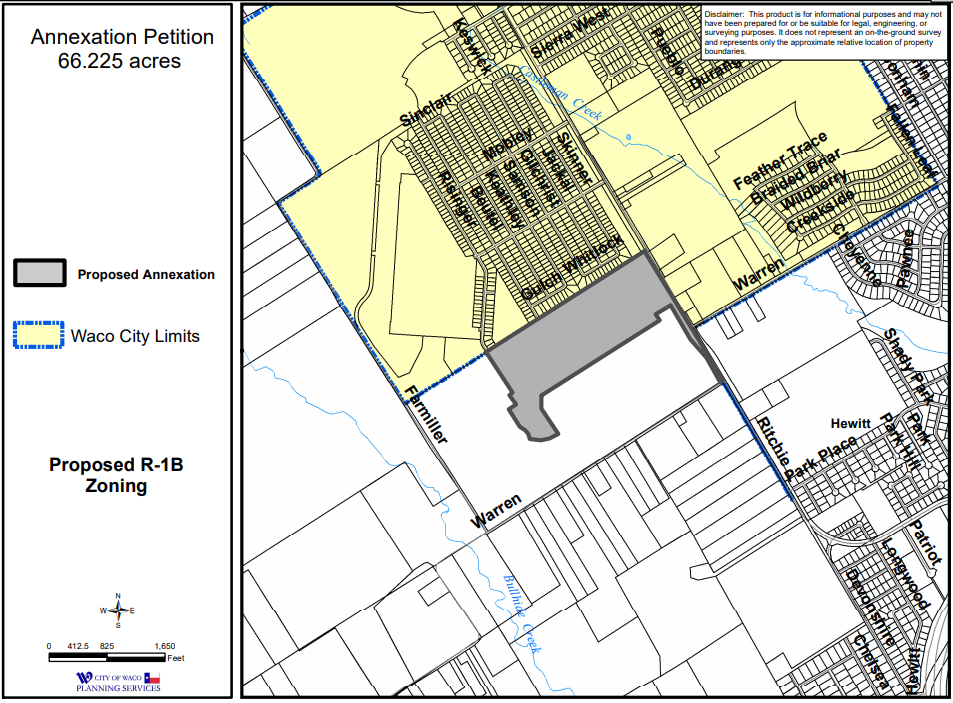
Why does the item mention Waco’s extraterritorial jurisdiction (ETJ)?
One of the requirements for annexation is that the land lay in the ETJ.
So, let’s go back to the initial sentence. We can now summarize it to mean: consider approving an agreement with a property owner to begin providing city services to a property described as x that is within Waco’s ETJ.
What comes next?
- November 17th – Public Hearing and First Reading/Vote
- December 1st – Second Reading/Vote
Other Interesting Items From the Agenda (to me)
- Impact fees are back for their second reading. There is also a work session item regarding how they could be changed in the future. This was one of the bigger questions Council member Holmes had two weeks ago.
- There are three Annexation Service Plans up for consideration. All in all they represent about 290 acres. The second and third of these plans are with the Waco Industrial Foundation which is an interesting topic for a different time.
- There are two resolutions and one ordinance related to Boards and Commissions. The resolutions are general and deal with approving appointments and clarifying certain language around advisory boards. The ordinance deals specifically with the Sustainable Resource Practices Advisory Board adjusting its mission, purpose, and membership.
Meeting Basics
- City Council meets on the first and third Tuesdays of every month.Work Session – 3:00 pm / Business Session – 6:00pm
- To watch the recorded session click here (City of Waco Cable Channel, wccc.tv)
- For the full agenda click here
- For the meeting packet with the documents pertinent to the meeting click here.

Jeffrey Vitarius has been actively local since early 2017. He lives in Sanger Heights with partner (JD) and his son (Callahan). He helped found Waco Pride Network and now serves as that organization’s treasurer and Pride Planning Chair. Jeffrey works at City Center Waco where he helps keep Downtown Waco clean, safe, and vibrant. He is a member of St. Alban’s Episcopal Church and graduated from Baylor in 2011.
The Act Locally Waco blog publishes posts with a connection to these aspirations for Waco. If you are interested in writing for the Act Locally Waco Blog, please email [email protected]for more information.
(City council, school board, planning commission, county commissioners – these groups and several others represent us. They do the day to day work of running our community. It is our responsibility to keep informed about their work so that we can help them represent us effectively. “Civic Insights” by Jeffrey Vitarius is a regular feature of Act Locally Waco. Its purpose is to help us understand decisions that shape our community so that we can participate effectively as informed, engaged residents of Waco. – ALW)
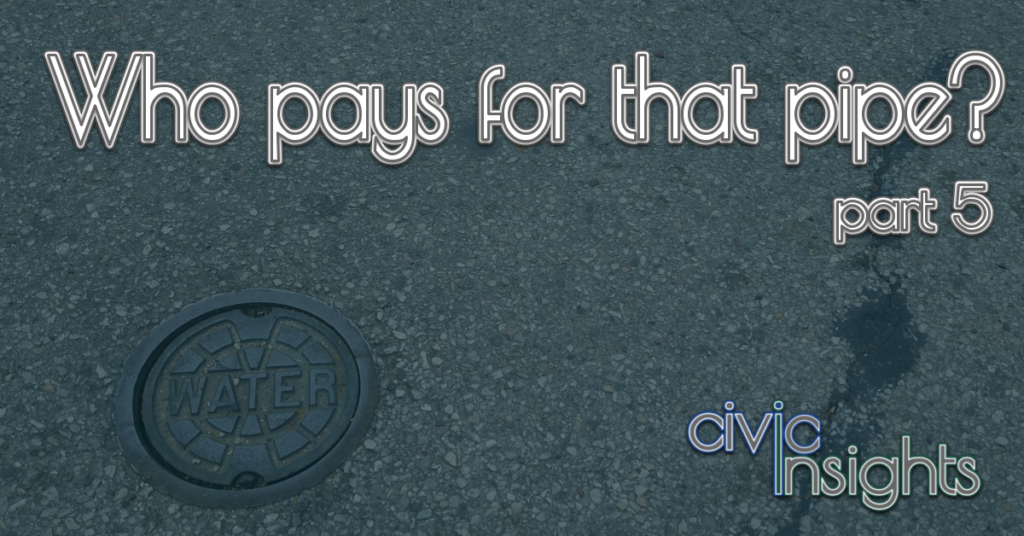
By Jeffrey Vitarius
We are finally coming to the end of the long impact fee process. This policy has been a goal of the city since it adopted the comprehensive twenty-five year plan in 2016. There has been intense study and discussion of the potential policy since Freese and Nichols (consulting firm) was hired to produce the study back in December of 2018. We have been writing about it here since early September. Last week, the City Council took its first vote on the initial policy that has been generated by this process. Another vote is scheduled for next Tuesday (November 6th) and this should be the final step.
Back in September, we started this discussion with a broad look at what an impact fee policy is. We moved from there to the legal process for establishing an impact fee, and finally to an examination of the pipe-related and road-related details of the Freese and Nichols report . That report will serve as the basis for any impact fee policy in Waco. Here in our final post, we will finally move from what impact fees could be to what they should be by examining the policy that was approved last week and the discussion that has occurred at the City Council level regarding how best to proceed.
The Policy
As a brief reminder, the Freese and Nichols report established the maximum allowable impact fees for water, wastewater, and roadways (the end of the could process). The results of that study are below.
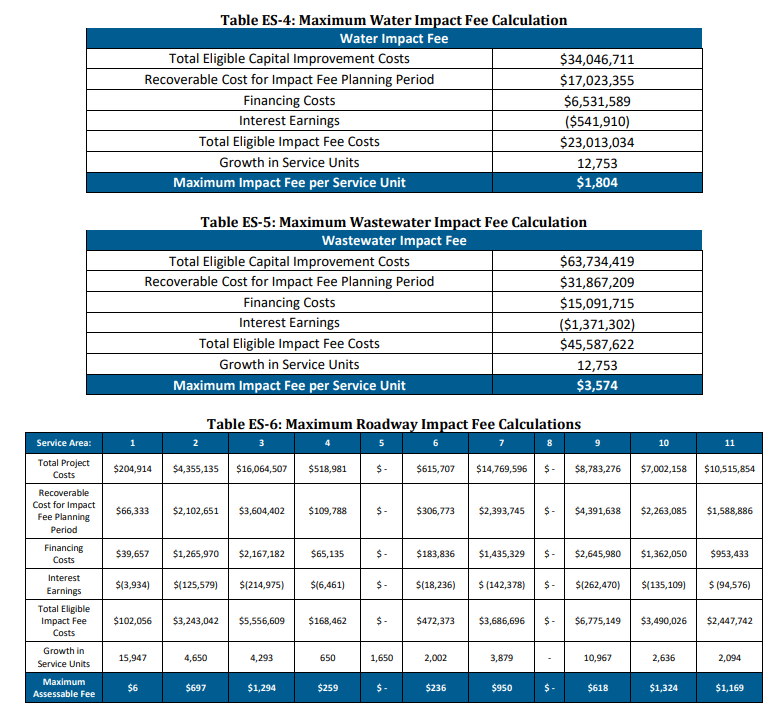
All of these maximums are based upon single-family home equivalency. So, the numbers above are the maximum allowable impact fees for a single-family home. For example, a single-family home in service area seven (near China Spring) could not have an impact fee above $6,328 ($1,804 – water + $3,574 – wastewater + $950 – roadway). Developments that are not made up of single-family homes have a maximum that is scaled based on calculations of use. So if a development is anticipated to use twice as much of the infrastructure as a single-family home, the maximum impact fee for that development is twice that of the single-family home (there is a lot more detail on this front in the last two posts).
The policy the city is in the process of adopting (found in more detailed form in the ordinance that was voted on last week) starts with base impact fees that are 100% of the allowable fees established above. However, to this base fee a number of exemptions, waivers, and limits are applied.
Below is a brief list of most but not all of these adjustments with some explanation of each:
- Residential Infill Waiver – single family homes in the “residential infill area” (map below) would have all impact fees waived
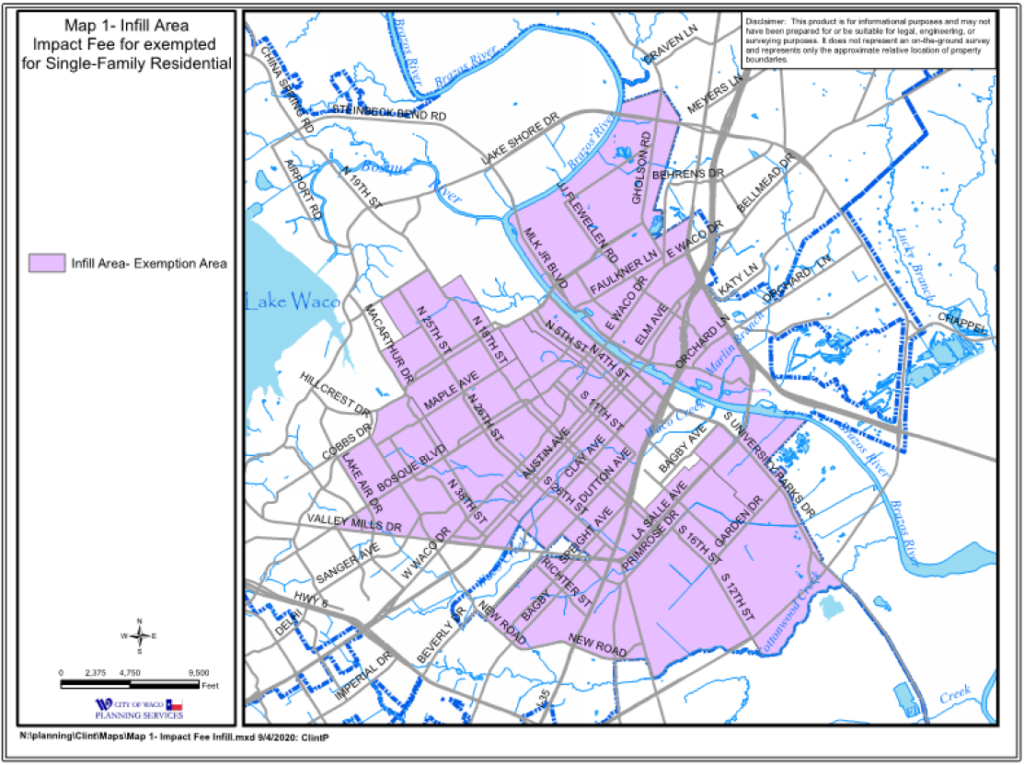
- Traditional Commercial Corridor Credit – non-single family home developments in the “traditional commercial corridor area” (map below) would have impact fees reduced by 50%
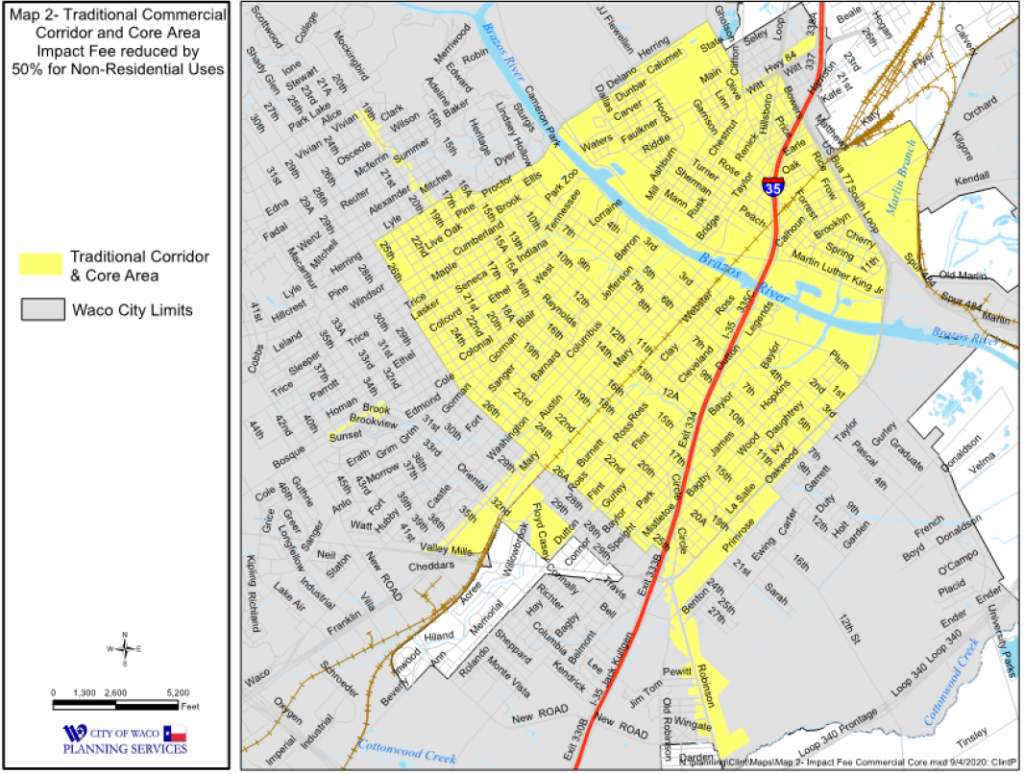
- Credits for construction of system-wide facilities – from a really broad view, if the development involves the construction of system-wide facilities (those kinds of infrastructure that are not just for the development itself) a credit to account for this construction would be applied to impact fees
- Affordable Housing Waiver – if a development has at least 25% affordable housing units (costing less than 30% of a household’s income for households making less than 80% of Waco’s median income) and an additional 25% that are either affordable or “workforce” units (costing less than 30% of a household’s income for households making between 80%-120% of Waco’s median income) impact fees would be waived. There are additional allowances for +sale units as well. Eagle eyed observers may spot that some of these percentages have appeared before in discussions of the CDBG program.
- Existing Business Waiver – if an existing business expands or relocates and the project fits with a collection of conditions (for example being open at least 2 years already, and documentations showing that the expansion or relocation will provide at least as many jobs as before) all impact fees would be waived.
- Phase-in elements – the policy has an effective date of June 1st, 2021. The fees would also be phased in over the course of five years (hitting 100% in June of 2024). There is also a waiver that would apply to projects that are nearly complete.
Each of these policy adjustments has some reasoning behind it and in most cases represents an effort to avoid disincentivizing certain kinds of development. It’s economics short-hand to say that if you make something more expensive you will get less of it (like most economics, I am sure there are disputes on this point, but the general rule remains). If affordable housing became more expensive to build due to impact fees, the theory goes that some number of units would not be built because of the increased cost. So, the above adjustments tend to exempt or reduce impact fees for the kinds of development that are high priorities for the city (infill residential, core commercial, affordable housing, etc). In addition to these adjustments, the policy gives the city the ability to grant waivers on a case by case basis as well.
The phase-in elements provide developers with some time to incorporate the new impact fees into their calculations and decision making.
The downside to these adjustments is that they make a complicated policy more complicated. Much of the discussion at City Council hit upon this point.
The Discussion
Over the course of the last two City Council meetings (10/06 and 10/20) there has been substantial discussion of the policy outlined above. In general, there has been support for impact fees in theory. Most points of concern have been focused on the specifics of the policy and its timeline for implementation.
The committee formed to analyze and make recommendations on the impact fee policy (the Capital Improvements Advisory Committee – CIAC) recommended the above policy with a single exception: that the implementation of commercial impact fees be delayed for six months (essentially pushing the effective date of commercial impact fees from June 1st, 2021 to December 1st, 2021).
This recommendation exception highlights one of the key elements of the discussion around this policy. The commercial impact fee calculation is substantially more complicated than the residential impact fee calculation. This makes sense, given the variety of developments that fit under the “commercial” umbrella. For commercial developments, the variety of kinds, sizes, locations, and exemptions all factor into the impact fee calculation. The city is working on a calculator to assist developers in navigating the detailed points of this part of the policy.
Additionally, concerns were focused on whether this policy strikes the right balance between funding the needed infrastructure projects and making sure not to disincentivize development. Since this policy is new, there were also questions about when and how it could be changed.
Input that was received from the public raised similar concerns and questions regarding balance and alternatives.
Arguments were made that the substantial phase-in elements of the policy and semi-annual review by the CIAC allowed for adjustment before the full impact of the fees would be felt by developers. Additionally, the importance of associating the costs of development with development rather than existing tax and ratepayers was emphasized. Ultimately the City Council voted 5-1 to approve the policy in its first vote. The Council will vote for a second and final time next Tuesday.
Thank you for walking through this review of impact fees with me. I hope to bring you something new or at least different in November. If there are any particular civic policy or issues you would like me to take more of a look at, please feel free to comment here. Thanks again.

Jeffrey Vitarius has been actively local since early 2017. He lives in Sanger Heights with partner (JD) and his son (Callahan). He helped found Waco Pride Network and now serves as that organization’s treasurer and Pride Planning Chair. Jeffrey works at City Center Waco where he helps keep Downtown Waco clean, safe, and vibrant. He is a member of St. Alban’s Episcopal Church and graduated from Baylor in 2011.
The Act Locally Waco blog publishes posts with a connection to these aspirations for Waco. If you are interested in writing for the Act Locally Waco Blog, please email [email protected]for more information.
(City council, school board, planning commission, county commissioners – these groups and several others represent us. They do the day to day work of running our community. It is our responsibility to keep informed about their work so that we can help them represent us effectively. “Civic Insights” by Jeffrey Vitarius is a regular feature of Act Locally Waco. Its purpose is to help us understand decisions that shape our community so that we can participate effectively as informed, engaged residents of Waco. – ALW)
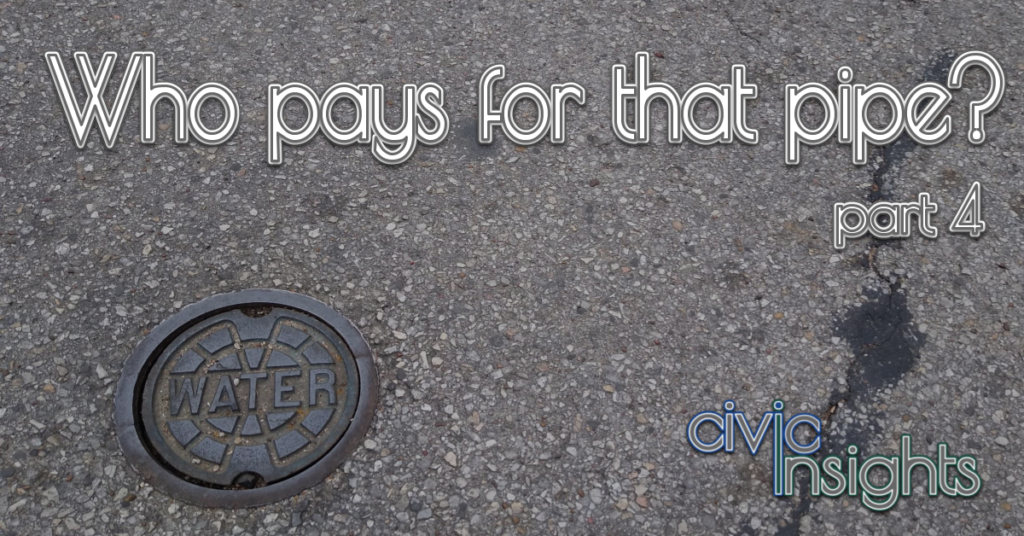
By Jeffrey Vitarius
Back in September, we began this series with a broad look at what an impact fee policy is. A month ago, we focused on the legal process for establishing an impact fee. Two weeks ago, we took a look at pipe-related details of the report that serves as the basis for any impact fee policy in Waco. This week, we’ll take a look at the road side of things. Then we will wrap up next week, by looking at the policy the City considered on October 20th.
As a bit of reminder, we are working our way through the following steps that were used to calculate maximum impact fees:
- Determine a service area
- Identify a way to connect demand for service to supply for service
- Calculate increased demand for services
- Review existing supply for services
- Determine and cost projects needed to meet increased demand
- Identify service unit to divide costs amongst projects
- Calculate maximum impact fees
1. Service Area
As you may recall from two weeks ago, service areas are the geographic boundaries of the impact fee policy. Chapter 395 provides guidance on what these areas can be or must be. For roads, there is a unique limitation that is not applied to pipes. Service areas for roads are limited to about twelve miles across (technically a six-mile radius). The reasoning here is that one part of town should not have to pay for the roads of a different part of town. For pipes the network is considered as a united system, whereas with roads smaller service areas are required. Additionally, a service area for roads cannot extend beyond the city limits (excluding the Extra-Terratorial Jurisdiction).
How these twelve mile “areas” are drawn is left up to the city or county looking to begin impact fees. For Waco the service areas ended up as this map:
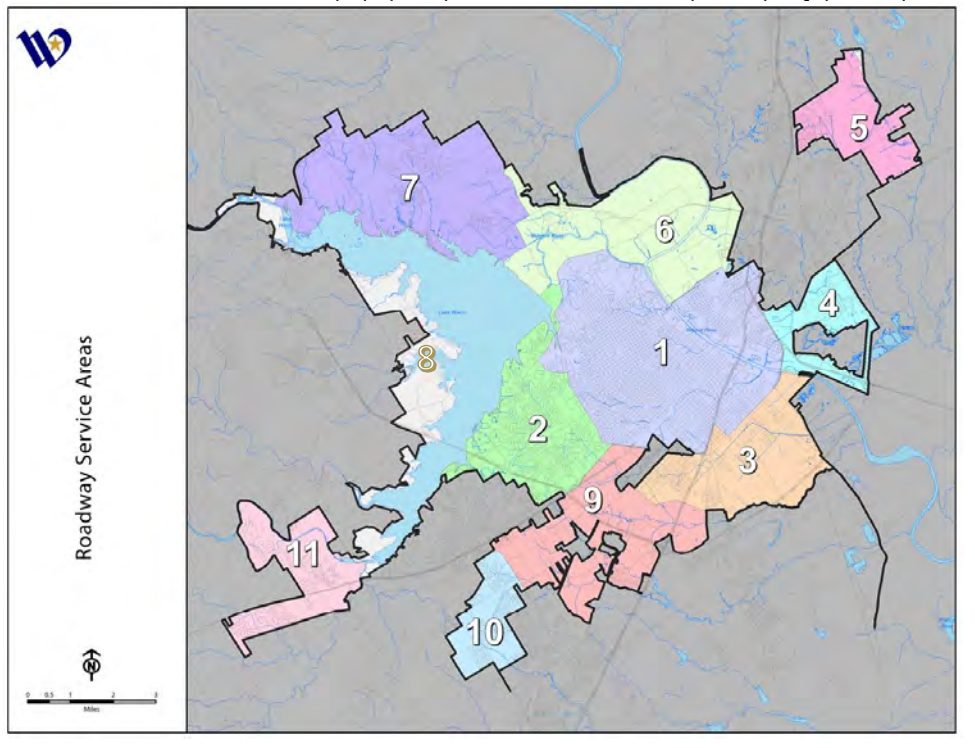
2. Connecting Demand and Supply
We will once again need to find some measurement to connect a new house or business park (demand) to the existing system of roads and any potential expansions (supply). The measurement needs to be scalable to the variety of demands that will come from new development and be measurable for distinct projects and supply systems. For roads, that measure is vehicle-mile at the PM peak hour. That probably needs some unpacking.
In thinking about the kind of measure we need here, the first impulse might be to simply count the cars. How many vehicles use the road system at any given point in time? That would get us part of the way there, but would miss a critical question: how far are those cars going? A car going a couple miles to a local restaurant “uses” substantially less roadway than a car going ten miles to work.
So we need to know not only how many cars are out there, but how far all of them are going. That is how we get to vehicle-miles. Ten cars going one mile has the same “vehicle miles” as one care going ten miles (10 cars x 1 mile = 10 vehicle-miles vs 1 car x 10 miles = 10 vehicle-miles).
On top of this, roadway use changes throughout the day, much like pipes (diurnal patterns). Road use peaks in the AM and the PM rush hours with less use in between. So, for the sake of impact fees the PM peak hour is used to measure vehicle-miles.
3. Increased Demand
Projecting how much Waco will grow overall, and where that growth will occur follows the exact same pattern that was used for pipes. For roads, however, a simple breakdown between growth in residents and employees will not be enough to fully capture the impact on roadways. For roads, the kind of employment becomes important.
We can see this if we think about the differences between a small industrial center and a retail park. Both may hire the same number of employees, but they generate substantially different vehicle-miles. At the industrial center, employees arrive and leave plus the occasional shipment of goods. However, at the retail center not only do you have employees and shipments coming and going, you also have customers.
To account for this our consultants, Freese and Nichols, broke employment growth down into basic, retail, and service categories. Each of these have a different impact on vehicle-miles. They then translated the number of new employees into anticipated square feet of use and bridged from that measure into vehicle-miles. For new residents, they looked at growth on a residences (rather than residents) basis.
Combining all this together they were able to project increased vehicle-mile demand for each of the service areas over the next ten years.
4. Existing Supply and 5. New Projects
A factor of particular importance in looking at how the current roadways will be able to accommodate the increased pressures of growth is how much are they currently being used. Pipes are metered. Water users are billed based on how much demand they put on the current systems. So it is fairly simple to gather information about current use. Roads are different. Their use is not tracked nearly as closely. For the sake of this study, Freese and Nichols relied on traffic counts that were collected on thirty separate locations across the city in May of 2019.
They then compared these counts to the traffic capacity of various road segments (think of these as the bits of road where the road stays the same, so the part of x drive that has four lanes is separated from the part that has two lanes). Capacity can normally be determined by looking at the design of the road. On a really rough level, you can see that I-35 has more capacity than Waco Drive which has more capacity than 10th Street. So looking at the current use and the design capacity of each roadway you can figure how many additional vehicle miles you can add in without needing to change the road (incidentally there are some roads that are already used more than their capacity, these “deficits” are ultimately taken out of the calculation of improvement cost since they are not a result of new demand).
Much like with pipes, Freese and Nichols along with City Staff then identified a number of improvements that might be eligible for impact fee funding. Unlike pipes, these projects were assigned to specific service areas. Where a project crossed the boundary between two service areas, its costs were split between the two. These projects were then examined for the amount of vehicle-mile capacity they added to the service area. So long as this added capacity was less than the increased demand in that service area (see step 3) the entire cost of the projects for that area could be included in the impact fee calculation. Where the added capacity was more than the increased demand, only that portion of the projects that covered the increased demand could be considered.
Combining all the allowable costs together, the report then applies the same 50% credit to the costs that we discussed with pipes. At the end of this process we have the total eligible impact fee cost – the total cost of increased capacity due to new demand after consideration of a credit for future taxes for each service area.
6. Service Unit
Chapter 395 calls for the establishment of a service unit specifically. It defines this (in broad terms) as a standardized measure of use. Although vehicle-miles remain a good connector between supply and demand, it is difficult to determine the exact number of vehicle-miles any given development would generate. So, the study scales vehicle-miles on the basis of a single-family residence. Basically, we look at each development in terms of how it relates to the demand generated by a single-family residence.
As was mentioned above, in general you can calculate the vehicle-miles produced by any given development based on its characteristics. We look at this in terms ultimately of trip total trip length. That is the number of vehicle-miles generated by the development. There are a number of interesting factors that go into this calculation (like trip generation, individual trip length, adjustments for diverted trips and local conditions), but we don’t have the space to get into all of these here. Instead we can go with a nice round number example. Let’s assume a single-family residence produces 4 miles of adjusted trip length and a retail store produces 12. The retail store will be scaled so that it can be measured as a multiple of a single family residence. With this example that multiple is 3 (12 divided by 4).
Here are some of the real ratios to give you an idea of how they work in the study. A hospital is anticipated to generate 1.72 times the demand of a single-family residence for every 1,000 square feet it contains. A clinic, in contrast, generates 5.81 times the demand of a single-family residence for every 1,000 square feet. These ratios allow for the generation of a comprehensible unit of measure to distribute the costs of the improvements.
7. Maximum Impact Fee
Knowing our service unit and our total eligible costs, the final step can be taken. A projection is made of the total new service units anticipated by development (for roads this projection relies heavily on land use assumptions since different kinds of development vary greatly in terms of trip generation). This projection is made on the basis of the service areas we noted above. For example, service area five as zero anticipated growth in service units. Whereas, service area one anticipates 15,947 new single-family resident equivalents. The chart below completes the process.
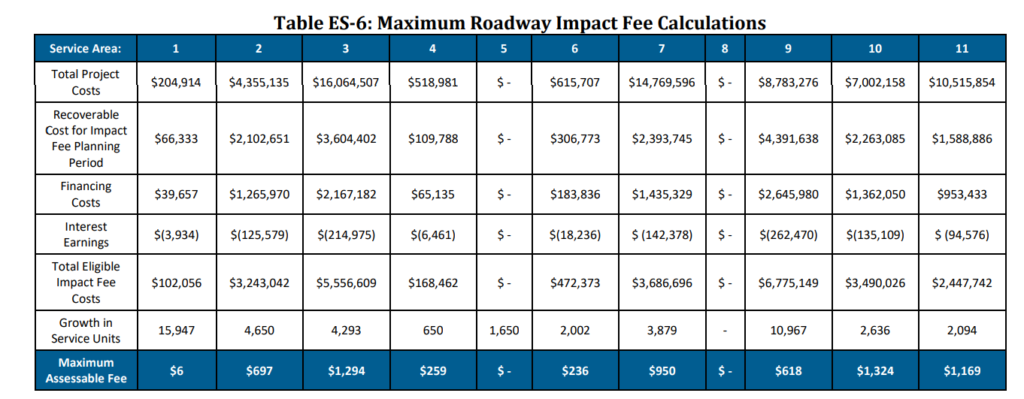
Here we see that after all these steps the maximum impact fee allowable by law for roads in service area one is $6 and for service area eleven is $1,169. These numbers are the final product of that could process we discussed at the very beginning of all of this. That is the process to determine what impact fees could be (as opposed to should be). Whatever the outcome of the should process is, the impact fees cannot exceed these amounts for a single-family residence equivalent.

Jeffrey Vitarius has been actively local since early 2017. He lives in Sanger Heights with partner (JD) and his son (Callahan). He helped found Waco Pride Network and now serves as that organization’s treasurer and Pride Planning Chair. Jeffrey works at City Center Waco where he helps keep Downtown Waco clean, safe, and vibrant. He is a member of St. Alban’s Episcopal Church and graduated from Baylor in 2011.
The Act Locally Waco blog publishes posts with a connection to these aspirations for Waco. If you are interested in writing for the Act Locally Waco Blog, please email [email protected]for more information.
(City council, school board, planning commission, county commissioners – these groups and several others represent us. They do the day to day work of running our community. It is our responsibility to keep informed about their work so that we can help them represent us effectively. “Civic Insights” by Jeffrey Vitarius is a regular feature of Act Locally Waco. Its purpose is to help us understand decisions that shape our community so that we can participate effectively as informed, engaged residents of Waco. – ALW)
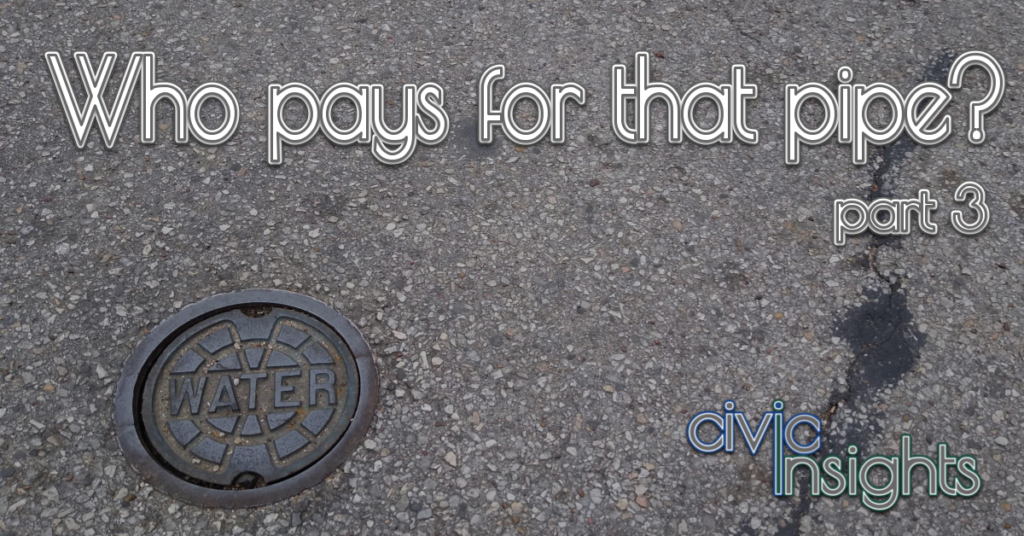
By Jeffrey Vitarius
Back in September, we began this series with a broad look at what an impact fee policy is. Two weeks ago, we focused on the legal process for establishing an impact fee. This week we will be taking a look at pipe-related details of the report that serves as the basis for any impact fee policy in Waco. Next week, we’ll take a look at the roadside of things. Then we will wrap up on the 23rd, by looking at the policy the City will be considering on the 20th.
The goal of this report (developed by Freese and Nichols, Inc) is to calculate the maximum impact fees that could be applied under Chapter 395 of the local government code. As we discussed two weeks ago this involves projecting what kind of development will occur, what the demands of that development will be, what projects will be needed to meet that demand, and how the cost of those projects can be divided up amongst the new developments (steps 2 and 4 of the legal process). How these calculations are conducted for pipes and roads are slightly different so we will take a look at each separately, but both follow a similar pattern of calculations. We will be addressing each step in detail below:
- Determine a service area
- Identify a way to connect demand for service to supply for service
- Calculate increased demand for services
- Review existing supply for services
- Determine and cost projects needed to meet increased demand
- Identify service unit to divide costs amongst projects
- Calculate maximum impact fees
Let’s start with the Pipes:
1. Service Area
Service areas are the geographic boundaries of the impact fee policy. All the new demand, all the projects, and all the fees should be contained within the service areas. Chapter 395 provides guidance on what these areas can be or must be. For pipes, the service area is fairly straightforward. It includes the city limits of Waco along with Waco’s extraterritorial jurisdiction (ETJ). An ETJ can be thought of as a “buffer” around the city where the city can exercise certain kinds of authority. For Waco, the ETJ extends approximately five miles beyond the city limits unless there is another city in the way. For example, Woodway is not in the City of Waco’s ETJ since it is its own city.
2. Connecting Demand and Supply
Here we need to find some measurement to connect a new house or business park (demand) to the existing system and potential projects (supply). The measurement needs to be scalable to the variety of demands that will come from new development and be measurable for distinct projects and supply systems. For pipes that measure is millions of gallons per day (MGD). So, for a new housing development, MGD measures the millions of gallons of water needed each day and the millions of gallons of wastewater produced each day.
Water systems have a unique difficulty in that they are not used consistently over days and years. This makes sense if you think through your personal use of the water system. In hot dry summers you are more likely to be watering a lawn than in cold or wet winters. You are unlikely to be using the water system at 1:00 am, but you are likely to be washing your clothes, or taking a shower, or washing your hands sometime in the early morning or afternoon (for those interested these daily patterns are also called “diurnal patterns”).
Due to these daily and annual changes, looking at average MGD does not give a full picture of the demands placed on the water system. Instead we have to look at maximum MGD as well. That is the maximum number of millions of gallons used on any one day during the year. Interestingly, the report uses a “maximum day to average day” ratio of 1.7 meaning it anticipates that on average a maximum day consumes 1.7 times as much water as an average day.
Finally, to calculate increased demand over time the report calculates average MGD per resident and employee (for water its 135 gallons per day per resident and 115 gallons per day per employee). There are some additional complications to the wastewater system, but the process is largely the same.
3. Increased Demand
Above we were able to tie increased demand for pipes to increases in population and employment. Now we need to figure out what that increase actually is and how it is geographically spread out (this impacts the specific projects that will need to be undertaken).
As we touched briefly on two weeks ago, we have to start with a broad look at how much Waco will grow in terms of population and employment into the future. To do that, the study begins with a look at the past. Between 1960 and 2010 Waco’s population grew on average 0.49% per year (the technical metric for those interested is compound annual growth rate). Between 2010 and 2020 the population grew by 1.11% per year. Additionally, the number of jobs in Waco was on average between 45-48% of the total population. So, for about every two people there was about one job. Due to this ratio being fairly constant, jobs can be considered to have grown at approximately the same rate as population.
Freese and Nichols then (in consultation with the Waco Capital Improvements Advisory Committee) took a look at a number of different growth rate scenarios and ultimately determined that 1.2% seemed like the most reasonable projection of population and employment growth in Waco for 2020-2040. Additionally, they noted growth was likely to be substantially greater in the ETJ (as there is more room for development in this area). For the ETJ they projected between 4.9% and 5% population growth and 4.06% and 5.74% employment growth. Now that we have general growth rate numbers, we need to understand how that growth is spread out geographically.
To divide growth geographically, the report uses “traffic analysis zones” (TAZs). These are geographic units used by the Waco Metropolitan Planning Organization (a good topic for a different time) for demographic analysis due to their internal similarity (areas within TAZs are similar to each other) and traffic generation. Here is a map of some of the TAZs within Waco. This map does not come from the impact fee study,but should give some understanding to what TAZs are.
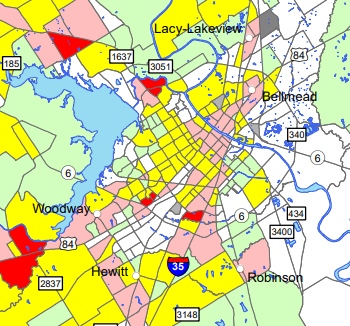
Freese and Nichols along with City Staff analyzed each TAZ. They looked at current development (what is already there), the potential for development (is there a big open field?), projected land use, and any specific projects that were known to be in the pipeline. Based on this analysis they were able to project growth in employment and population within specific TAZs. Here is an example of the result:

A quick side note, the land use assumptions used in this analysis come from Waco’s Comprehensive Plan 2040. This was the same plan that identified the impact fee policy as critical.
Now we know: a) expected new residents and employees in each TAZ and b) expected new pipe usage based on new residents and employees. Combining the two we know how much water/wastewater will be needed and where it will be needed.
4. Existing Supply & 5. New Projects
Now that demand is known geographically, Freese and Nichols along with City Staff were able to identify where the existing system would need to be upgraded to meet with the projected demand (this process involved a review of other recent studies focused on the subject). The result is a list of twenty-three water projects and seventeen wastewater projects. Here are some examples: a 16-inch water line at Peach Street, a 1.0 MG ground storage tank at the airport, a wastewater treatment plant in China Spring, and a lift station expansion at TSTC. Costs for each of these projects were calculated based on the rules established by Chapter 395 (which is fairly specific about what kinds of costs may or may not be included).
Since impact fees cannot be used to support existing development or development that will take place over 10-years from now, the report takes each of these projects and determines what percentage of the project’s capacity would be used right now, and what percentage would be used in 2030. For example, the 16-inch water line at Peach Street would be used at 25% capacity today and 60% capacity in 2030. That means 35% of the project cost can be considered to be the cost of new development between 2020 and 2030.
Combining all the allowable costs together, the report then applies a 50% credit to the costs. This credit is meant to represent the future tax revenues that will come from the increase in development. Essentially it represents how the new development will “pay” for these improvements through the regular tax process rather than the impact fee.
At the end of this process we have the total eligible impact fee cost – the total cost of increased capacity due to new demand after consideration of a credit for future taxes (water – $23,013,034, wastewater – $45,587,622). But how do we divide those costs up so that individual developments pay for them as they come into existence?
6. Service Unit
Chapter 395 calls for the establishment of a “service unit.” It defines “service unit” (in broad terms) as a standardized measure of consumption. Since it would be virtually impossible to determine the exact number of residents or employees a development would have, we cannot use the same metric we used to connect demand and supply (MGD per resident and MGD per employee).
Ultimately, for this study the connection of a single-family residence was used as the base service unit. The study then measures all other kinds of water and wastewater connections on the scale of single-family residence equivalents (on the basis of average flow). For an example a business park connection might be considered equivalent to ten single-family residences since ten times the amount of water flows through it (this is not a number used in the study, but rather a nice round one for an example).
7. Maximum Impact Fee
Knowing our service unit and our total eligible costs, the final step can be taken. A projection is made of the total new service units anticipated by development (in much the way step 3 proceeded). In the case of water and wastewater that number is 12,753. That is, the study anticipates that 12,753 “single-family resident connection equivalents” will be added to the water and wastewater system over the next ten years. With that number in hand, it is a simple matter of division to determine the maximum impact fee. The chart below completes the process.

Here we see that after all these steps the maximum impact fee allowable by law for water is $1,804 and for wastewater is $3,574. These numbers are the final product of that could process we discussed at the very beginning of all of this. Whatever the outcome of the should process is, the impact fees cannot exceed these amounts for a single-family residence connection equivalent.

Jeffrey Vitarius has been actively local since early 2017. He lives in Sanger Heights with partner (JD) and his son (Callahan). He helped found Waco Pride Network and now serves as that organization’s treasurer and Pride Planning Chair. Jeffrey works at City Center Waco where he helps keep Downtown Waco clean, safe, and vibrant. He is a member of St. Alban’s Episcopal Church and graduated from Baylor in 2011.
The Act Locally Waco blog publishes posts with a connection to these aspirations for Waco. If you are interested in writing for the Act Locally Waco Blog, please email [email protected]for more information.
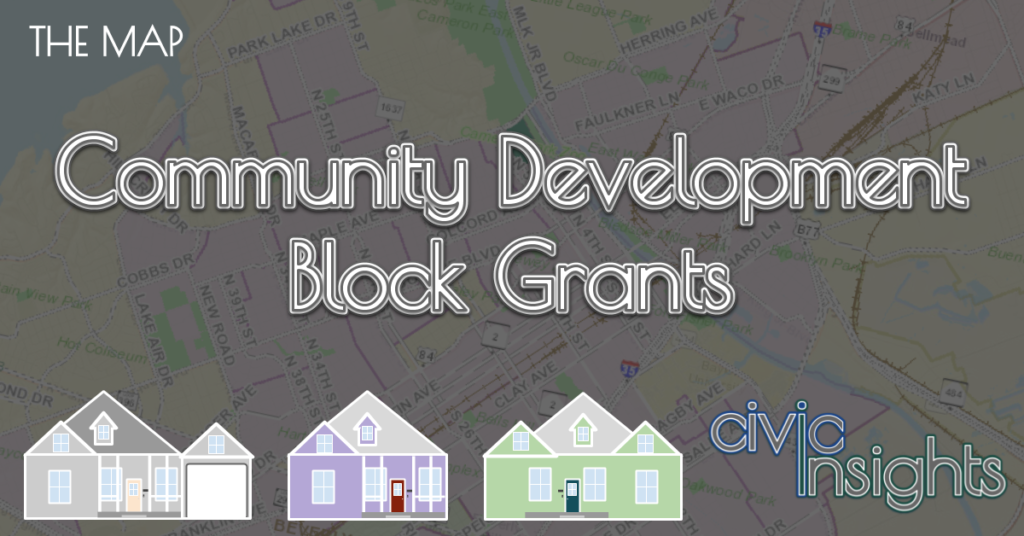
(City council, school board, planning commission, county commissioners – these groups and several others represent us. They do the day to day work of running our community. It is our responsibility to keep informed about their work so that we can help them represent us effectively. “Civic Insights” by Jeffrey Vitarius is a regular feature of Act Locally Waco. Its purpose is to help us understand decisions that shape our community so that we can participate effectively as informed, engaged residents of Waco. – ALW)
By Jeffrey Vitarius
Two weeks ago we tackled breaking down a sentence about the City Council’s Community Development Block Grant (CDBG) public hearing. During the course of the City Council’s review of that item, Council Member Sabio raised a question regarding this map of CDBG eligible areas:

It was noted at the meeting that the borders included above come from the federal government and are based on census information. I thought it might be interesting to find out the how and why behind this map. Let’s jump right in.
The CDBG program was created by the Housing and Community Development Act of 1974 (HCDA). Section 104(b)(3) of the act identifies the three “national objectives” of the program:
- Benefiting low- and moderate-income persons,
- Preventing or eliminating blight, or
- Meeting an urgent need (this one is a little complicated)
CDBG funding has to go towards achieving one of these objectives.
As noted in the Department of Housing and Urban Development (HUD)’s Guide to National Objectives and Eligible Activities for CDBG Entitlement Communities benefiting low- and moderate income persons “is usually spoken of as the most important national objective of the CDBG program because of the related requirement that the vast majority of CDBG expenditures must be for activities that meet this objective.” Translation, most programs are directed towards the benefiting low- and moderate-income persons objective. Also, as an FYI, entitlement communities are local governments that develop CDBG programs and receive funding to implement them (like the City of Waco).
The question then becomes how does an “entitlement community” establish that a particular program or project is benefiting low- and moderate-income persons. HUD has outlined four different ways to meet this goal. A program can simply serve a limited clientele. If a particular program only or mostly provides services to low- and moderate-income folks, then it can easily be said to be fulfilling the national objective.
But what if a program or project doesn’t serve specific people? What is the “clientele” of a park? This is where the “area benefit” criteria comes into play. For this method the “entitlement community” identifies the service area of a program or project. If most of the residents (defined as 51%) in that service area have a low- or moderate-income the project can be considered to fulfill the national objective.
This possibility opens up a host of other questions. What income level makes a resident a low- or moderate-income? How do you determine a service area? What data can be used to determine if an area has low- or moderate-income residents? We’ll tackle each of these questions in more detail below. But first let’s take one quick sidestep to the remaining two criteria. Housing development and job creation programs are unique enough to warrant their own criteria. We do not have the space this week to delve into those criteria, but it’s worthwhile to know they are out there.
Back to our questions.
What income level makes a resident a low- or moderate-income?
Section 102 of the HCDA defines low- or moderate-income as 80% of the median income in the area. So first you determine an area’s “median family income.” This is the income you would find at the exact middle of Waco’s income distribution (for the math folks, we are looking at median here rather than mean or average). If you put all the family incomes from Waco in order it would be the one at the middle of your list. HUD identifies this as $65,700 in Waco. 80% of that number is approximately $52,550. Once you scale this for family size (larger families have a higher income threshold), you can determine if any given resident is low- or moderate-income. More details on these thresholds can be found at this useful tool put together by HUD.
How do you determine a service area?
Service area is the kind of idea that makes a lot of sense in theory and is really hard to define in practice. If you think back to our park example, you can probably imagine what the area served by that park might be, but if you had to sit down and draw it out on a street grid, it would get difficult fast. How far away is walking distance? Do we consider residents who can drive? Do busy streets separate “service areas” from one another?
As a result of this complexity HUD has placed the responsibility of determining service areas on “entitlement communities.” The guide I noted above states that “HUD will generally accept a grantee’s determination unless the nature of the activity or its location raises serious doubts about the area
claimed by the grantee.” Basically, as long as the service area doesn’t “look fishy” HUD will likely accept it as reasonable.
The range of what is or isn’t reasonable is very broad here. Based on the information in the City’s consolidated and annual plans (see this previous post for more info on what those plans are) it looks like Waco focuses on “block groups.” These are the smallest geographic units used by the census. You can think of them as literal groups of city blocks. According to the census, block groups typically have between 3,000 and 6,000 residents. The map at the beginning of this post breaks down Waco into these “block groups.”
What data can be used to determine if an area has low- or moderate-income residents?
So thinking of a “typical” block group of 5,000 residents. We now know that it is considered a low- or-moderate income service area if 2,550 (51%) of those residents reside in families (the distinction between families and households is interesting, but complicated and out of our reach here) that make less than 80% of median income for Waco. So how do we actually know if that is the case?
There are two ways HUD has endorsed for a community to accomplish this. The first is to use HUD’s own data (the Low Moderate Income Survey Data [LMISD]). The second is to conduct their own survey of residents following certain HUD guidance and minimum standards. Waco uses HUD’s data. That data can be found using this GIS application provided by HUD. On that application you can draw out service areas or just take a look at block groups and see which ones clear the 51% threshold (HUD provides a useful video introduction to the application here).
If we look at Waco’s consolidated five-year plan we find a section focused on geographic distribution (AP-50). In that section the city notes:
The City allocates infrastructure and facility improvements (not related to special needs populations [remember our limited clientele option]) within the CDBG Target Areas — those census block groups with 51% or more low to moderate-income residents.
This brings us back to the map at the top. There we find all of the block groups in Waco where at least 51% of the residents make less than 80% of Waco’s median income. These areas are the focus of much of Waco’s CDBG funding. Over time, as income levels move and data changes, this map will change too.

Jeffrey Vitarius has been actively local since early 2017. He lives in Sanger Heights with partner (JD) and his son (Callahan). He helped found Waco Pride Network and now serves as that organization’s treasurer and Pride Planning Chair. Jeffrey works at City Center Waco where he helps keep Downtown Waco clean, safe, and vibrant. He is a member of St. Alban’s Episcopal Church and graduated from Baylor in 2011.
The Act Locally Waco blog publishes posts with a connection to these aspirations for Waco. If you are interested in writing for the Act Locally Waco Blog, please email [email protected]for more information.

(City council, school board, planning commission, county commissioners – these groups and several others represent us. They do the day to day work of running our community. It is our responsibility to keep informed about their work so that we can help them represent us effectively. “Civic Insights” by Jeffrey Vitarius is a regular feature of Act Locally Waco. Its purpose is to help us understand decisions that shape our community so that we can participate effectively as informed, engaged residents of Waco. – ALW)
By Jeffrey Vitarius
Two weeks ago, we took a broad look at impact fees as a policy. In that post, I noted that Waco is in the transition between the could part of the adoption process and the should part of the adoption process. This week, let’s dive into some of the details of the “could” work that has already been done.
The impact fee adoption process (both could and should)is governed by Local Government Code Chapter 395 – Financing Capital Improvements Required by New Development in Municipalities, Counties and Certain Other Local Governments. The local government code can be seen from a high level as “rules for cities and counties.” Different chapters of the code deal with different issues. For example Chapter 372 provides the rules around how PIDs are established and maintained, Chapter 102 deals with municipal budgets, and Chapter 309 addresses arts and entertainment districts.
Chapter 395 lays out in detail how a City or County could go about establishing impact fees. It, for example, defines capital improvements as facilities that are expected to last at least three years, are owned and operated by a “a political subdivision” (read city or county, though there are other kinds of political subdivisions. Incidentally this is also defined in Chapter 395), and are water supply, treatment, and distribution facilities; wastewater collection and treatment facilities; storm water, drainage, and flood control facilities (pipes), or roadway facilities (roads).
Chapter 395 identifies a six-part process in adopting impact fees (more details on these steps below):
- Establish an Advisory Committee
- Develop a Capital Improvements Plan
- Hold a Public Hearing on Land Use Assumptions and Capital Improvements Plan and Potentially Approve these Items
- Calculate Maximum Impact Fee Per Service Unit
- Hold a Public Hearing on Impact Fees
- Potentially Approve Adoption of Impact Fees
Right now Waco is between steps four and five. Step five is scheduled with a public hearing on October 6th and based on Chapter 395 step six would have to occur within thirty days of that public hearing. Let’s take a look at each of the steps that have already occurred in a little more detail.
1. Establish an Advisory Committee
Chapter 395 requires that the “governing body of the political subdivision” (in this case the City Council of Waco) establish a committee to weigh in throughout the impact fee adoption process. The code makes it clear that this committee needs to include at least one voice from the real estate, development, or building industries to speak into the impact fee process. These are the industries most likely to bear the cost of an impact fee. The code also tasks this committee with providing advice on the adoption of land use assumptions, file written comments on the capital improvements plan (more on that below), and reviewing the progress of the capital improvements plan over time.
The City Council created such a committee on July 16th 2019 and it held its first meeting on July 23rd, 2019. Since that time it has met regularly to review and provide input to this process.
2. Develop a Capital Improvements Plan
The development of the Capital Improvements Plan is likely the most complicated part of the entire impact fee process. If you remember back to the post two weeks ago, I used the simple example of a new set of homes on what used to be a farm. Under those conditions it is easy to trace certain infrastructure improvements to that specific development. However, in reality, the city needs to be able to project (theoretically) all of the developments that are going to take place over the next ten years andthe capital improvements that go along with those developments. That difficult projection work (which we will take a closer look at another time) is compiled into a Capital Improvements Plan. For right now we will just take a summary view.
From a high level you can think through the process of developing this plan in the following way. First, you need to make some assumptions about land use. You need to know how it is anticipated that land not currently developed will be used if developed. There is a big difference between a farm turning into the Central Texas Marketplace and the same farm becoming a set of one-story single-family homes. These assumptions are so critical to the process that they are explicitly listed as being part of the Capital Improvements Plan public hearing.
Once you identify how land is likely to be used, you can work on projecting how much different parts of town will grow. You combine the amount of growth and the land use assumptions together to figure out what kind of growth will occur (once again the Central Texas Marketplace and single-family suburbs are very different). Knowing what kind of growth is projected to occur, lets you know how much increased demand for water, wastewater, and roadways there will be.
Next, you compare projected need against the capacity of the current system to see what projects will be needed by the anticipated demand. Where will you need to increase the size of a pipe or lay down a new road? Finally, you establish projected budgets for the needed projects. The result (of this and some additional analysis noted below) is a two-hundred and thirty-four page study. In Waco, this work was conducted by Freese and Nichols, Inc with input from the advisory committee and various City Departments. Once this analysis is complete it is ready to be reviewed by the public and potentially approved by City Council.
3. Hold a Public Hearing on Land Use Assumptions and Capital Improvements Plan and Potentially Approve these Items
The City held a public hearing on the Land Use Assumptions and Capital Improvements Plan on March 17th, 2020. At that time there were no public comments. The City Council passed RES-2020-237 approving the Land Use Assumptions and Capital Improvements Plan at its next regular meeting on April 7th, 2020.
4. Calculate Maximum Impact Fee Per Service Unit
Once the Land Use Assumptions and Capital Improvements Plan are approved a calculation can be done that (in the broadest sense) divides the cost of the capital improvements needed by the number of new “service units” (think individual houses) generated by new developments. The result is the maximum impact fee that can be imposed per service unit. There are some details regarding this analysis that we won’t get into this week, but this provides a high-level overview. This analysis is also included in the lengthy study linked to above.
This calculation was presented to City Council on August 18th, 2020. At that time the council discussed the process. Concerns were expressed on both sides of the policy (that implementation might discourage development or that not implementing would burden resident taxpayers with the cost of these improvements). It was noted that peer cities had implemented impact fees.
That gets us caught up with the process so far. I hope to be back to with a more detailed look at that Freese and Nichols study around the time of the public hearing on the subject.
Meeting Basics – Waco Capital Improvements Advisory Committee – 09/23/20
- Regular Meeting – 12:00 pm
- For the full agenda click here

Jeffrey Vitarius has been actively local since early 2017. He lives in Sanger Heights with partner (JD) and his son (Callahan). He helped found Waco Pride Network and now serves as that organization’s treasurer and Pride Planning Chair. Jeffrey works at City Center Waco where he helps keep Downtown Waco clean, safe, and vibrant. He is a member of St. Alban’s Episcopal Church and graduated from Baylor in 2011.
The Act Locally Waco blog publishes posts with a connection to these aspirations for Waco. If you are interested in writing for the Act Locally Waco Blog, please email [email protected]for more information.
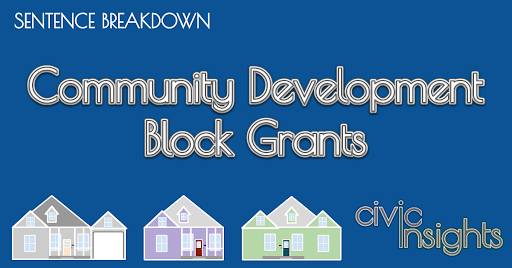
(City council, school board, planning commission, county commissioners – these groups and several others represent us. They do the day to day work of running our community. It is our responsibility to keep informed about their work so that we can help them represent us effectively. “Civic Insights” by Jeffrey Vitarius is a regular feature of Act Locally Waco. Its purpose is to help us understand decisions that shape our community so that we can participate effectively as informed, engaged residents of Waco. – ALW)
By Jeffrey Vitarius
This week we are going to try to unpack the following sentence: “The City Council held a public hearing as part of a series of public hearings and eventually action regarding the 2020-2021 Annual Action Plan for Community Development Block Grant (CDBG) and HOME Investment Partnership Program (HOME) funding.” Let’s jump right in.
What is Community Development Block Grant (CDBG) and HOME Investment Partnership Program funding?
In the broadest sense, these two programs are funding sources from the federal government to local governments, like the City of Waco, to accomplish certain federal priorities. It is theoretically a way for the federal government to pay for services and projects that advance federal goals without directly managing the programs themselves.
The City’s Consolidated Plan (more on that later) provides a good summary of the goals of each of these programs. The CDBG program is aimed at developing urban communities with decent housing, suitable living environments and economic opportunities for low and moderate-income folks. The HOME program has a more focused mission and is aimed at developing affordable housing (both to rent and to own) for low and moderate-income folks.
In Waco this funding has gone to:
- Rehabilitation of owner-occupied housing (including items like roof repairs)
- Code compliance inspections (making sure that housing is “in code” with the standards the city uses to assess livability)
- Job training
- Emergency Housing
- Down Payment Assistance
- Rental Assistance
- Park Improvements (including at Wilbert Austin Sr. Park, Kendrick Park, Dewey Park, Oscar DuConge Park, South Waco Park, North Waco Park, and Bell’s Hill Park)
For the 2020-2021 fiscal year the Annual Action Plan is anticipating funding of $2,082,261. This is less than 0.5% of the City’s overall budget, but the programs funded in this way are critical to some of Waco’s most challenging problems.
The Consolidated Plan notes that the greatest of these challenges is housing affordability. Generally speaking, housing is considered affordable if housing costs are less than 30% of income. In Waco, 39.1% of households spend more than 30% of their income on housing and 21.06% of households spending over 50% of their income on housing.
What is a Consolidated Plan?
The Consolidated Plan is a long-term (five years) look at how the City will use funding from the CDBG and HOME programs to pursue the goals of those programs. The plan breaks down how it was developed, what needs it identifies, how it anticipates meeting those needs, and what resources and partners will be needed in pursuing the programs it lays out.
The development of a Consolidated Plan is a requirement for pursuing this kind of funding, as is the development of Annual Action Plans.
What is an Annual Action Plan?
An Annual Action Plan takes the five-year nature of the Consolidated Plan and looks at what will occur over the next year. This week, the public hearing was focused on the 2020-2021 Annual Action Plan which is the second such plan under the 2019-2023 Consolidated Plan.
Why did the City Council hold a public hearing on the Annual Action Plan?
Given that the services and projects funded by the CDBG and HOME programs are meant to serve the needs of the public, the development of both Consolidated Plans and Annual Action Plans require a good deal of public input. The need for “citizen participation” is so great in these programs that generating this participation gets a plan of its own.
As Raynesha Hundell, Interim Director of Community Services, presented to City Council this week, the City has pursued citizen input through a number of different routes. While preparing the annual action plan they met with neighborhood associations and gathered approximately one-hundred and sixty surveys on the matter. They used this input to identify priorities for this year’s action plan.
Now that an annual action plan has been drafted, the citizen participation plan requires that there be a thirty-day period where the public may review and comment on the Annual Action Plan. That thirty-day period began on the 10th of this month and will conclude on the 9th of October. The participation plan also requires that a public hearing occur during the thirty-day window for public input. The hearing this week was that hearing.
So, let’s go back to our initial sentence: “The City Council held a public hearing as part of a series of public hearings and eventually action regarding the 2020-2021 Annual Action Plan for Community Development Block Grant (CDBG) and HOME Investment Partnership Program (HOME) funding.” I hope that is a little clearer now. As I feel like I keep saying, there is a lot more to unpack in this topic. The presentation that was made to council this week serves as a great introduction.
What happened at City Council?
City Council was broadly supportive of the draft Annual Action Plan and its program-based approach to distributing funding. Additionally, Council Member Sabido asked follow-up questions regarding the map determining where CDBG and HOME funds could be spent (another interesting topic for a different day).
What comes next?
- To October 9th – Public Comment Period Continues
- September 15th – Draft Annual Action Plan Public Hearing
- October 6th – Draft Annual Action Plan Public Hearing
- October 20th- Annual Action Plan will return to City Council for approval
- October 23rd – Annual Action Plan will be submitted to the Department of Housing and Urban Development (HUD) that oversees the CDBG and HOME programs
Other Interesting (to me) Items From the Agenda
- The planning items that were reviewed by the Plan Commission back in August have now made it to the City Council for their review.
- Now that the budget has been passed, there are a number of resolutions concerning contracts the City will need as it pursues the priorities of that budget. These range from procurement of Microsoft 365 to repairing the elevator at the Zoo’s administration building. As City Manager Bradley Ford noted during the City Council Meeting this week, “This agenda is a great one, as well as the first one in October, to read in order to get an understanding of the breadth and depth of municipal operations.”
- The Downtown PID Service and Assessment Plan we discussed two weeks ago has returned for final approval.
Meeting Basics
- Work Session – 3:00 pm / Business Session – 6:00pm
- To watch the recorded session click here (City of Waco Cable Channel, wccc.tv)
- For the full agenda click here
- For the meeting packet with the documents pertinent to the meeting click here.

Jeffrey Vitarius has been actively local since early 2017. He lives in Sanger Heights with partner (JD) and his son (Callahan). He helped found Waco Pride Network and now serves as that organization’s treasurer and Pride Planning Chair. Jeffrey works at City Center Waco where he helps keep Downtown Waco clean, safe, and vibrant. He is a member of St. Alban’s Episcopal Church and graduated from Baylor in 2011.
The Act Locally Waco blog publishes posts with a connection to these aspirations for Waco. If you are interested in writing for the Act Locally Waco Blog, please email [email protected]for more information.
